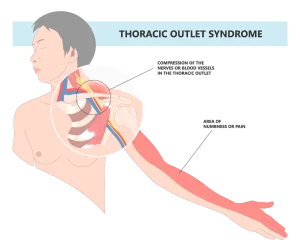Treatment for Thoracic Outlet Syndrome
At DFW Spine & Pain Institute, we take a tiered approach to treating TOS, starting with conservative therapies and progressing to more advanced solutions if needed. Our goal is to relieve your symptoms while preserving function and avoiding unnecessary surgery whenever possible.
Non-Surgical Treatments for TOS
Many patients find significant relief through targeted, non-surgical therapies:
Physical Therapy
A structured physical therapy program can help strengthen postural muscles, stretch tight areas, and reduce nerve or vascular compression.
Medication Management
We may recommend anti-inflammatories, nerve pain medications, or muscle relaxants to reduce discomfort and improve daily functioning.
Selective nerve blocks can help identify the exact source of pain and provide temporary relief for patients with neurogenic TOS.
BOTOX® Injections
For patients with chronic muscle tightness contributing to nerve compression, BOTOX can relax muscles and ease symptoms.
Lifestyle & Posture Coaching
Posture correction and ergonomic adjustments play a key role in long-term management and symptom prevention.
This non-invasive therapy stimulates affected nerves and may reduce pain and restore function in patients with nerve-related symptoms.
For patients with chronic TOS pain that hasn’t responded to traditional therapies, ketamine can help calm overactive nerve signaling.
Advanced & Surgical Options
If non-surgical approaches fail to provide lasting relief, we may explore more advanced interventions in collaboration with your care team:
Vascular Surgery Consultation
Patients with arterial or venous TOS may require surgical decompression or vascular repair performed by a specialized surgeon.
Minimally Invasive Decompression
In select cases of neurogenic TOS, minimally invasive procedures may be used to release the scalene muscles or remove an extra rib.
Surgery is always a last resort, and our team will guide you through your options with compassion, clarity, and evidence-based recommendations.
Prevention Strategies for Thoracic Outlet Syndrome
Preventing TOS involves addressing modifiable risk factors and maintaining optimal musculoskeletal health:
- Maintain proper posture: Especially during computer work and daily activities
- Regular exercise: Focus on strengthening postural muscles
- Ergonomic workspace: Proper desk height, monitor position, and keyboard placement
- Avoid repetitive overhead activities: Take frequent breaks during prolonged overhead work
- Weight management: Maintain healthy body weight to reduce compression risk

